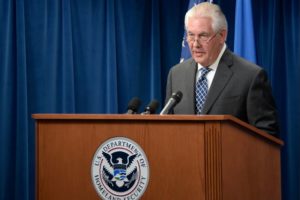
With Tourism Declining, US Should Focus on Rebranding Abroad
Tourism is an important industry in the US – it supports 1 in 9 jobs, accounts for 11% of total US exports, and is America’s number one service export. However, despite the regional successes of groups like BrandUSA and a surprisingly strong start to 2017, the most recent numbers show that international travel to the US has continued to decline, even as tourism has boomed internationally. Going forward, the US should clarify that its doors are still open for business and institute bilateral initiatives to tap into growing markets.
The travel ban put into place by the Trump Administration may be playing a role in the decline. Beyond the obvious effect of restricting travel from countries specifically named, the travel ban projects an image of America as a country that is not particularly welcoming to foreigners, and the current administration has made no effort to counter that narrative.
Repercussions have been tangible – demand for flights to the US has dropped, and some airlines have started cutting the number of flights they offer to the US. According to analytics firm Tourism Economics, the overall result could be 4.3 million fewer people visiting the US in 2017 alone, as well a 7.4 billion dollar loss of revenue.

Secretary of State Rex Tillerson speaking on President Trump’s Executive Order on Protecting the Nation from Foreign Terrorist Entry in to the United States – March 6th, 2017
The travel ban and consequent drop in tourism forces Americans to answer the question of whether they’re willing to sacrifice tourism for security, and reconcile the relationship between the two. In a video outlining the state of 2017 tourism, Roger Dow, CEO of the US Travel Association, stated that it is “vital for our national security for the world to see and experience our cities, our natural wonders and attractions, and the hospitality of our people.” National security and tourism are not mutually exclusive, and in fact tourism can help our national security by creating a grassroots level of cultural understanding.
So what’s the solution? Jonathan Grella, Executive VP of the US Travel Association, has suggested that the solution might be something as simple as a little rebranding.
One organization that focuses almost exclusively on US branding to international tourists is the aptly named Brand USA. Created in 2011, Brand USA enjoys bipartisan support and is funded without taxpayer money (instead levying a fee on visitors from countries without a visa requirement). However, the President’s FY 2018 budget cuts the program and shifts all revenue to Customs and Border Protection.
While it is unlikely that BrandUSA will be cut in the final form of the budget bill passed by Congress, the president’s budget sends an important message about the administration’s priorities when it comes to the question of tourism and security.
In addition to continued support of BrandUSA, the US might think about taking a page out of the playbook of its northern neighbor. In 2018, Canada and China will participate in the Canada-China Year of Tourism, an initiative designed to increase tourism revenue for both countries and to facilitate cultural understanding. Much to Canada’s benefit, China has one of the largest markets for international tourists.
If the US looks to target a specific nation in the coming years, the Trump Administration might consider a similar tactic. Not only would this spur the number of visitors from the chosen country, it would signal to the world that the US has not closed its doors.
If the US were to attempt a program like Canada and China’s, there are some things that should be kept in mind:
1.) Preparation – For this program to really take off, it has to become more than just some words on a piece of paper. A recent example of Canadian preparation can be seen here: a celebration of the Mid-autumn festival that is tailored for a Chinese and a Canadian audience.
Happy Mid-Autumn Festival to everyone celebrating around the world! #CanadaChinaYearofTourism🇨🇦🇨🇳 pic.twitter.com/Z30vP6wsHq
— Bardish Chagger (@BardishKW) October 4, 2017
2.) Attitude – Additionally, it’s important that the American people are behind the initiative. The value of people-to-people connections is nonexistent if there is a basic lack of respect and enthusiasm on the part of the host. That means that on an individual level, employees in tourist-heavy destinations have to be prepared to treat international arrivals warmly.
As ASP’s David Woodside has previously pointed out, homeland security policies don’t necessarily spell bad news for the travel industry. By affirming support for branding initiatives and engaging in bilateral initiatives, the US can continue to be a premier destination for tourists around the world.





